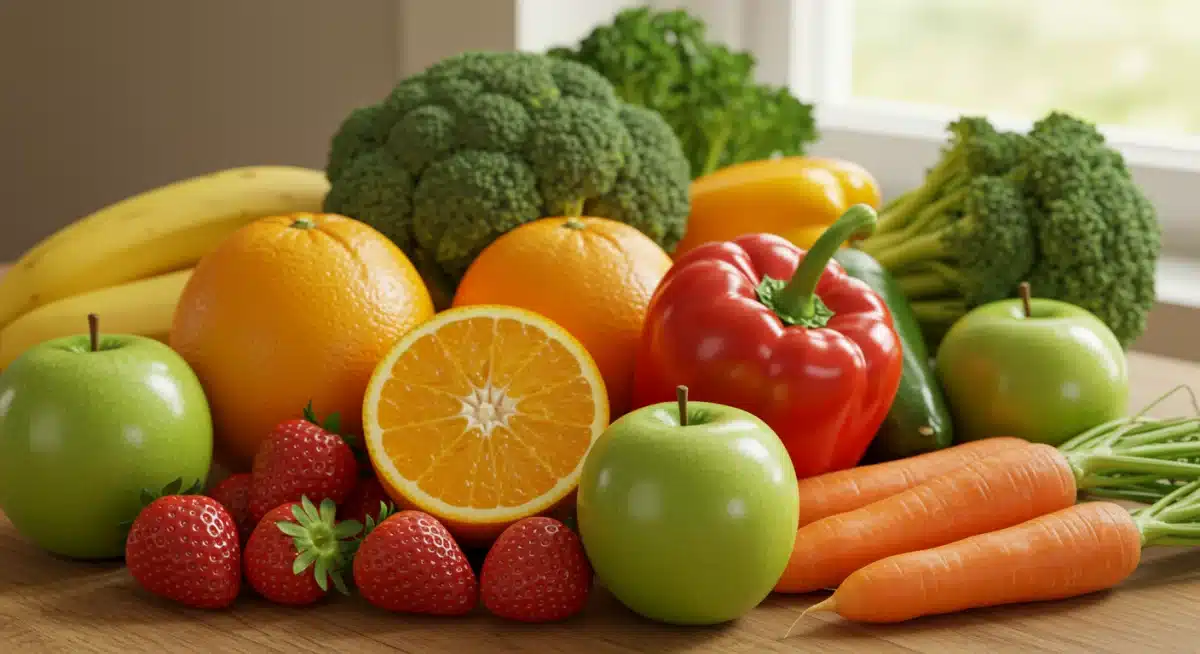Hidden Sodium in Kids’ Diets: 5 Sneaky Sources & How to Cut Back

Advertisement
Many common foods surprisingly contain high levels of sodium, significantly impacting children’s health. Identifying these hidden sources and implementing simple dietary adjustments can lead to healthier eating habits for the entire family.
Understanding the impact of sodium on children’s health is crucial for every parent. While often associated with adult health concerns, excessive sodium intake in childhood can lay the groundwork for future health issues. This article will explore 5 sneaky sources of sodium in your child’s diet (and how to reduce them), offering practical advice to help your family make healthier food choices.
Advertisement
The silent threat of sodium: more than just the salt shaker
Sodium, an essential mineral, plays a vital role in maintaining fluid balance, nerve function, and muscle contractions within the body. However, in today’s modern diet, particularly for children, the intake of sodium often far exceeds what is necessary or healthy. This excess isn’t typically from the salt shaker at the dinner table, but rather from processed and packaged foods that are staples in many American households.
Advertisement
High sodium consumption in childhood is a significant public health concern. It’s strongly linked to elevated blood pressure in children, which can escalate into hypertension in adulthood, increasing the risk of heart disease and stroke. Beyond cardiovascular health, excessive sodium can also contribute to other issues like kidney problems and bone density loss over time. Educating ourselves on where this hidden sodium lurks is the first step towards safeguarding our children’s long-term well-being.
Understanding recommended sodium intake for children
The American Heart Association recommends that children aged 1 to 3 should consume no more than 1,500 mg of sodium per day, while those aged 4 to 18 should aim for less than 2,300 mg. These guidelines are often surprisingly difficult to meet given the prevalence of high-sodium foods. Many parents are unaware of just how much sodium their children are getting, making it challenging to regulate intake effectively.
- Infants (0-12 months): Very little added sodium; primarily from breast milk or formula.
- Toddlers (1-3 years): Aim for less than 1,500 mg daily.
- Children (4-8 years): Aim for less than 1,900 mg daily.
- Older Children/Teens (9-18 years): Aim for less than 2,300 mg daily.
These recommendations highlight the need for vigilance. The focus should be on reducing overall sodium intake from all sources, not just obvious ones. By making conscious choices, parents can significantly impact their children’s health trajectory, setting them up for a lifetime of healthier habits and reduced risk of chronic diseases.
In conclusion, while sodium is essential, its overconsumption is a silent threat to children’s health. Understanding recommended limits and the sources of hidden sodium is paramount for parents aiming to foster healthy dietary habits and protect their children from future health complications associated with high sodium intake.
Sneaky source 1: processed meats and poultry
Processed meats are a go-to for many busy families due to their convenience and child-friendly appeal. Items like hot dogs, deli meats, bacon, and chicken nuggets often find their way into lunchboxes and dinner plates. However, these seemingly innocuous foods are frequently loaded with sodium, not just for flavor but also for preservation and texture.
The manufacturing process for these products involves curing, salting, smoking, or adding chemical preservatives, all of which contribute significantly to their sodium content. A single serving of deli turkey, for example, can contain hundreds of milligrams of sodium, quickly adding up when consumed regularly. Even seemingly healthier options like pre-packaged grilled chicken strips can be surprisingly high in sodium.
Reading labels for sodium content
Becoming a label detective is essential when navigating the processed meat aisle. Always check the nutrition facts panel for sodium content per serving. Look for terms like “sodium nitrite,” “sodium phosphate,” or simply “salt” high up on the ingredient list. Many brands now offer lower-sodium versions of popular processed meats, which can be a better choice, but still require careful consideration.
- Hot dogs: A single hot dog can contain over 500 mg of sodium.
- Deli turkey: Often 300-500 mg per 2 oz serving.
- Bacon: High in sodium and saturated fat.
- Chicken nuggets: Can range from 300-600 mg per serving depending on the brand and preparation.
Reducing reliance on these items doesn’t mean eliminating them entirely, but rather making informed choices and seeking out alternatives. Opting for fresh, unprocessed meats and cooking them at home gives you complete control over sodium levels, seasoning them with herbs and spices instead of salt. When processed options are necessary, choose those explicitly labeled “low sodium” or “reduced sodium” and consume them in moderation.
Processed meats and poultry, despite their convenience, represent a significant hidden source of sodium in children’s diets. By diligently checking food labels and prioritizing fresh alternatives, parents can effectively reduce this sneaky sodium intake and promote healthier eating habits for their children.
Sneaky source 2: canned soups and packaged meals
Canned soups and pre-packaged meals are lifesavers for many parents on busy weeknights. They’re quick, easy to prepare, and often marketed as wholesome options. However, these convenience foods are notorious for their extremely high sodium content, which is used not only for flavor enhancement but also as a preservative to extend shelf life.
A single serving of canned chicken noodle soup, for instance, can easily contain half or more of a child’s daily recommended sodium intake. Frozen dinners, microwaveable pasta dishes, and instant noodle cups are equally problematic. These items are designed for maximum convenience, but this often comes at the cost of nutritional quality, particularly concerning sodium levels.
Choosing healthier convenience options
While cutting out all convenience foods might not be realistic for every family, making smarter choices can significantly reduce sodium exposure. Many brands now offer “low sodium” or “reduced sodium” versions of their soups and meals. It’s crucial to compare labels, as even these options can still contain more sodium than desired. Always check the serving size, as often a container holds more than one serving, leading to an unwitting increase in sodium intake.
- Canned soups: Look for less than 140 mg of sodium per serving.
- Frozen meals: Prioritize options with whole grains and vegetables, and lower sodium counts.
- Instant noodles: Often contain over 1,000 mg of sodium per cup; use sparingly or make homemade versions.
A great strategy is to doctor up low-sodium canned soups or broths by adding fresh vegetables, lean protein, and herbs to boost flavor and nutrition without adding more salt. For packaged meals, consider using them as a base and adding fresh components. Preparing meals in larger batches on weekends and freezing individual portions can provide homemade convenience without the added sodium. This approach gives you control over ingredients and ensures your child is getting a more balanced, less sodium-heavy meal.
Canned soups and packaged meals, while convenient, are significant contributors to a child’s high sodium diet. By reading labels carefully and opting for lower-sodium versions or incorporating fresh ingredients, parents can significantly lower their children’s sodium intake from these common sources.

Sneaky source 3: bread, rolls, and baked goods
It might seem counterintuitive, but everyday staples like bread, rolls, and even some baked goods can be surprisingly high in sodium. While they don’t taste overtly salty, sodium is used extensively in baking for flavor, structure, and as a leavening agent. For many children, these items form a significant part of their daily diet, often consumed multiple times a day as toast, sandwiches, or snacks.
A single slice of whole wheat bread, which many consider a healthy choice, can contain over 100 mg of sodium. When you consider a child might eat two slices for a sandwich, plus a roll with dinner, the sodium quickly accumulates without parents even realizing it. Even sweet baked goods like muffins or pastries can contain hidden sodium, balancing out flavors and contributing to overall intake.
Making smarter bread choices
To reduce sodium from this category, the key is to be selective. Look for breads labeled “low sodium” or compare nutrition labels to find brands with the lowest sodium content per slice. Opt for whole grain options, as they offer more fiber and nutrients, but still check the sodium. Baking your own bread or muffins at home is an excellent way to control sodium levels entirely, allowing you to reduce or even omit added salt without compromising taste or texture too much.
- Commercial breads: Can range from 100-200 mg per slice.
- Bagels and rolls: Often higher in sodium than sliced bread.
- Sweet baked goods: Can contain hidden sodium for flavor balance.
Consider alternatives to traditional bread for sandwiches, such as lettuce wraps, rice cakes (unsalted), or tortillas (check sodium content). When buying baked goods, choose those made with minimal ingredients and avoid highly processed varieties. Encouraging children to enjoy fresh fruits and vegetables as snacks instead of bread-based items can also help reduce overall sodium intake while boosting nutrient consumption.
Bread, rolls, and baked goods represent a less obvious, yet significant, source of sodium in children’s diets. By choosing low-sodium versions, baking at home, and exploring alternative bases for meals, parents can effectively manage this hidden sodium and promote a healthier dietary pattern for their families.
Sneaky source 4: sauces, dressings, and condiments
Sauces, dressings, and condiments are often overlooked sodium culprits. They are used to enhance the flavor of meals, making healthy foods more appealing to children. However, many popular varieties, from ketchup and barbecue sauce to soy sauce and salad dressings, are packed with sodium, often in surprisingly high amounts per serving.
A single tablespoon of ketchup can contain over 150 mg of sodium, and children often use much more than that. Soy sauce is even higher, with just one tablespoon potentially exceeding 1,000 mg. Even seemingly healthy options like light salad dressings can be sodium bombs. These additions, while small in volume, contribute significantly to a child’s daily sodium intake, often without parents realizing the extent of their impact.
Controlling sodium through condiment choices
To tackle this sneaky source, it’s essential to become discerning about your condiment choices. Always check the nutrition labels for sodium content. Many brands now offer “low sodium” or “reduced sodium” versions of popular sauces and dressings. These are generally better options, but still require moderation. Better yet, consider making your own sauces and dressings at home.
- Ketchup: Often 150-180 mg per tablespoon.
- Barbecue sauce: Can be 200-300 mg per tablespoon.
- Soy sauce: Over 1,000 mg per tablespoon (opt for low-sodium).
- Salad dressings: Varies widely, but many are high in sodium.
Homemade dressings and sauces allow you to control all ingredients, including salt. You can use herbs, spices, vinegar, lemon juice, and healthy oils to create flavorful alternatives without the added sodium. For example, a simple vinaigrette made with olive oil, apple cider vinegar, Dijon mustard, and a touch of honey offers robust flavor without excessive salt. When using store-bought options, encourage children to use them sparingly or dilute them with water or vinegar.
Sauces, dressings, and condiments are often underestimated sources of sodium in a child’s diet. By carefully reading labels, opting for low-sodium versions, and prioritizing homemade alternatives, parents can significantly lower their children’s sodium intake while still enjoying flavorful meals.
Sneaky source 5: cheese and dairy products
Cheese is a beloved food for many children, often incorporated into snacks, sandwiches, and meals. While dairy products are excellent sources of calcium and protein, many varieties of cheese, particularly processed types, can be surprisingly high in sodium. This sodium contributes to flavor and acts as a preservative, extending the shelf life of the product.
A single slice of American cheese, commonly used in grilled cheese sandwiches, can contain over 300 mg of sodium. Even natural cheeses like cheddar or mozzarella can have significant sodium levels. Cheese sticks, string cheese, and other popular child-friendly cheese snacks also contribute to daily sodium intake, often in amounts that parents might not anticipate.
Selecting lower-sodium dairy options
Reducing sodium from cheese and dairy requires a strategic approach. While it’s not necessary to eliminate cheese entirely, choosing lower-sodium options and moderating portion sizes can make a big difference. Look for natural cheeses that are lower in sodium, such as fresh mozzarella, Swiss, or ricotta. Always check the nutrition label for the sodium content per serving.
- Processed American cheese: Often 300-400 mg per slice.
- Cheddar cheese: Around 180-200 mg per ounce.
- Cottage cheese: Can be very high; look for low-sodium varieties.
- String cheese/cheese sticks: Typically 150-200 mg per stick.
Consider incorporating other calcium-rich, low-sodium dairy alternatives into your child’s diet, such as plain yogurt or milk. When using cheese, pair it with fresh fruits or vegetables to create a balanced snack that reduces the overall sodium load. Educating children about portion sizes and encouraging them to enjoy cheese in moderation can also help manage their sodium intake effectively. For recipes, you can often reduce the amount of cheese used without sacrificing flavor, or opt for stronger-flavored cheeses that allow you to use less.
Cheese and certain dairy products, despite their nutritional benefits, can be a sneaky source of sodium for children. By selecting lower-sodium varieties, being mindful of portion sizes, and incorporating other healthy dairy options, parents can ensure their children receive adequate calcium without excessive sodium.

Practical strategies for reducing sodium in your child’s diet
Reducing sodium in your child’s diet doesn’t have to mean bland meals or drastic changes. It’s about being more aware of what’s in their food and making small, consistent adjustments. The cumulative effect of these changes can lead to significant improvements in their overall health and well-being. The goal is to gradually shift taste preferences away from overly salty foods, allowing children to appreciate natural flavors.
One of the most effective strategies is to cook more meals at home. When you prepare food from scratch, you have complete control over the ingredients, including how much salt is added. Experiment with herbs, spices, lemon juice, and vinegar to add flavor without relying on sodium. Involving children in the cooking process can also make them more interested in trying new, healthier foods.
Empowering children with healthy choices
Teaching children about healthy eating from a young age can empower them to make better food choices as they grow. Explain why too much salt isn’t good for their bodies in simple terms. Encourage them to try a variety of fresh, unprocessed foods, and celebrate when they choose healthier options. Making healthy eating a family effort sets a positive example and fosters a supportive environment.
- Read food labels diligently: Always check sodium content, even in foods you think are healthy.
- Choose fresh over processed: Prioritize whole foods like fruits, vegetables, and lean proteins.
- Limit restaurant and fast food: These options are often very high in sodium.
- Cook at home: Control salt levels and experiment with natural flavor enhancers.
- Offer plenty of water: Hydration is important, and can sometimes curb cravings for salty snacks.
Gradually reduce the amount of salt you add during cooking and at the table. Your family’s taste buds will adjust over time, and you’ll find that foods taste just as good, if not better, with less sodium. Remember, consistency is key. Small, sustainable changes are more effective in the long run than drastic, short-lived dietary overhauls. By implementing these strategies, you can significantly reduce the hidden sodium in your child’s diet and set them on a path toward lifelong health.
Successfully reducing sodium in your child’s diet involves a combination of informed choices, home cooking, and consistent effort. By adopting these practical strategies, parents can effectively combat the hidden sodium threat and foster healthier eating patterns for their entire family, paving the way for improved long-term health outcomes.
| Sneaky Source | Reduction Strategy |
|---|---|
| Processed Meats | Choose fresh meats; look for low-sodium deli options. |
| Canned Soups | Opt for low-sodium versions or make homemade. |
| Bread & Baked Goods | Select low-sodium breads; bake at home to control salt. |
| Sauces & Condiments | Use low-sodium options or prepare homemade versions. |
Frequently asked questions about sodium in children’s diets
High sodium intake in children can lead to elevated blood pressure, increasing the risk of hypertension and heart disease later in life. It can also contribute to kidney issues and may impact bone health. Early exposure to high sodium can also shape taste preferences towards salty foods.
For children aged 1-3, the recommendation is less than 1,500 mg per day. For those aged 4-8, it’s under 1,900 mg, and for 9-18 years, less than 2,300 mg. These limits are often exceeded due to hidden sodium in processed foods.
Yes, absolutely. Taste buds are highly adaptable. By gradually reducing the amount of salt in meals and offering naturally flavorful foods, children will learn to appreciate less salty tastes over time. This shift is crucial for long-term healthy eating habits.
While many processed foods are high in sodium, not all are. It’s essential to read nutrition labels carefully. Many brands now offer low-sodium or reduced-sodium versions of popular items. Prioritizing whole, unprocessed foods is generally the best approach to minimize sodium intake.
Excellent low-sodium snack options include fresh fruits, raw vegetables with a low-sodium dip, plain yogurt, unsalted nuts or seeds, air-popped popcorn (without added salt), and homemade whole-grain muffins with minimal added salt. These provide nutrients without excessive sodium.
Conclusion
Navigating the complex world of children’s nutrition can be challenging, especially when hidden ingredients like sodium lurk in unexpected places. By understanding the 5 sneaky sources of sodium in your child’s diet (and how to reduce them) – processed meats, canned soups, bread, sauces, and cheese – parents are empowered to make more informed choices. Implementing strategies such as diligent label reading, prioritizing home-cooked meals, and opting for fresh, unprocessed foods can profoundly impact a child’s health. These conscious efforts not only reduce immediate sodium intake but also cultivate healthier eating habits that can last a lifetime, safeguarding their well-being for years to come.





